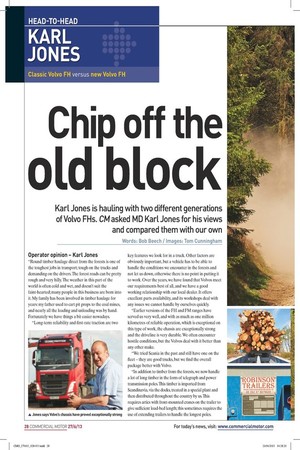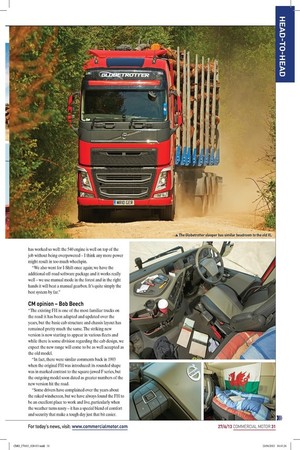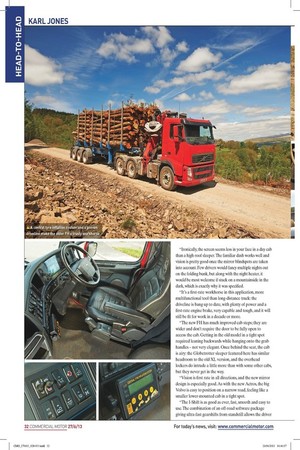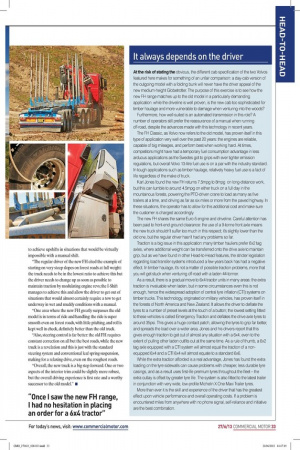Chip off the Old 1:110Ck Karl Jones is hauling with
Page 20

Page 22

Page 23

Page 24

Page 25

If you've noticed an error in this article please click here to report it so we can fix it.
two different generations of Volvo FHs. CM asked MD Karl Jones for his views and compared them with our own Words: Bob Beech / Images: Tom Cunningham Operator opinion Kart Jones "Round timber haulage direct from the forests is one of the toughest jobs in transport; tough on the trucks and demanding on the drivers. The forest roads can be pretty rough and very hilly. The weather in this part of the world is often cold and wet, and doesn't suit the faint-hearted; many people in this business are born into it. My family has been involved in timber haulage for years: my father used to cart pit props to the coal mines, and nearly all the loading and unloading was by hand. Fortunately we have things a bit easier nowadays.
"Long-term reliability and first-rate traction are two key features we look for in a truck. Other factors are obviously important, but a vehicle has to be able to handle the conditions we encounter in the forests and not let us down, otherwise there is no point in putting it to work. Over the years, we have found that Volvos meet our requirements best of all, and we have a good working relationship with our local dealer. It offers excellent parts availability, and its workshops deal with any issues we cannot handle by ourselves quickly.
"Earlier versions of the FH and FM ranges have served us very well, and with as much as one million kilometres of reliable operation, which is exceptional on this type of work, the chassis are exceptionally strong and the driveline is very durable. We often encounter hostile conditions, but the Volvos deal with it better than any other make.
"We tried Scania in the past and still have one on the fleet — they are good trucks, but we find the overall package better with Volvo.
"In addition to timber from the forests, we now handle a lot of long timber in the form of telegraph and power transmission poles. This timber is imported from Scandinavia, via the docks, treated in a special plant and then distributed throughout the country by us. This requires artics with front-mounted cranes on the trailer to give sufficient load-bed length; this sometimes requires the use of extending trailers to handle the longest poles. Ironically, we often find our trucks taking these poles to remote locations for contractors to erect and then reloading shorter length timber from nearby forests and taking it to sawmills and other processing plants.
"We also have tractor units with the crane mounted on the truck chassis: this allows one tractor to load flat trailers in the forest and leave them for other tractor units to collect. The last truck we had in this form is the FH540 6x4 with the day cab; the shorter cab meant that we could use a more compact wheelbase and still fit the big crane with an elevating operator's cab. This improves conditions for the driver in the winter. This truck might spend most of its working day in the forest loading trailers and I can testify that it gets pretty cold sitting on top of a crane all day.
"While we still run a number of 6x2 tractors, we are gradually moving over to 6x4s — the extra traction it gives is worth the extra fuel use and increase in unladen weight. In addition, nearly all of our trucks have central tyre inflation systems fitted, where the tyre pressures can be lowered at the flick of a button to give a far bigger contact area. This is very effective and makes the tyres less prone to punctures and cuts in the forest. In many cases, the forestry authorities demand it be fitted because it reduces damage on their road system.
"Once I saw the new FH range, I had no hesitation in placing an order for a 6x4 tractor. We wanted the same driveline specification as the earlier FH day cab because it has worked so well: the 540 engine is well on top of the job without being overpowered — I think any more power might result in too much wheelspin.
"We also went for I-Shift once again; we have the additional off-road software package and it works really well — we use manual mode in the forest and in the right hands it will beat a manual gearbox. It's quite simply the best system by far."
CM opinion Bob Beech "The existing FH is one of the most familiar trucks on the road: it has been adapted and updated over the years, but the basic cab structure and chassis layout has remained pretty much the same. The striking new version is now starting to appear in various fleets and while there is some division regarding the cab design, we expect the new range will come to be as well accepted as the old model.
"In fact, there were similar comments back in 1993 when the original FH was introduced: its rounded shape was in marked contrast to the square-jawed F series, but the outgoing model soon dated as greater numbers of the new version hit the road.
"Some drivers have complained over the years about the raked windscreen, but we have always found the FH to be an excellent place to work and live, particularly when the weather turns nasty — it has a special blend of comfort and security that make a tough day just that bit easier. "Ironically, the screen seems less in your face in a day cab than a high-roof sleeper. The familiar dash works well and vision is pretty good once the mirror blindspots are taken into account. Few drivers would fancy multiple nights out on the folding bunk, but along with the night heater, it would be most welcome if stuck on a mountainside in the dark, which is exactly why it was specified.
"It's a first-rate workhorse in this application, more multifunctional tool than long-distance truck: the driveline is bang up to date, with plenty of power and a first-rate engine brake, very capable and tough, and it will still be fit for work in a decade or more.
"The new FH has much improved cab steps; they are wider and don't require the door to be fully open to access the cab. Getting in the old model in a tight spot required leaning backwards while hanging onto the grab handles — not very elegant. Once behind the seat, the cab is airy: the Globetrotter sleeper featured here has similar headroom to the old XL version, and the overhead lockers do intrude a little more than with some other cabs, but they never get in the way.
"Vision is first rate in all directions, and the new mirror design is especially good. As with the new Actros, the big Volvo is easy to position on a narrow road, feeling like a smaller lower-mounted cab in a tight spot.
"The I-Shift is as good as ever, fast, smooth and easy to use. The combination of an off-road software package giving ultra-fast gearshifts from standstill allows the driver to achieve upshifts in situations that would be virtually impossible with a manual shift.
"The regular driver of the new FH cited the example of starting on very steep slopes on forest roads at full weight: the truck needs to be in the lowest ratio to achieve this but the driver needs to change up as soon as possible to maintain traction by modulating engine revs; the I-Shift manages to achieve this and allow the driver to get out of situations that would almost certainly require a tow to get underway in wet and muddy conditions with a manual.
"One area where the new FH greatly surpasses the old model is in terms of ride and handling: the ride is super smooth even on forest roads, with little pitching, and roll is kept well in check, definitely better than the old truck.
"Also, steering control is far better: the old FH requires constant correction on all but the best roads, while the new truck is a revelation and this is just with the standard steering system and conventional leaf spring suspension, making for a relaxing drive, even on the roughest roads.
"Overall, the new truck is a big step forward. One or two aspects of the interior trim could be slightly more robust, but the overall driving experience is first rate and a worthy successor to the old model." •








































